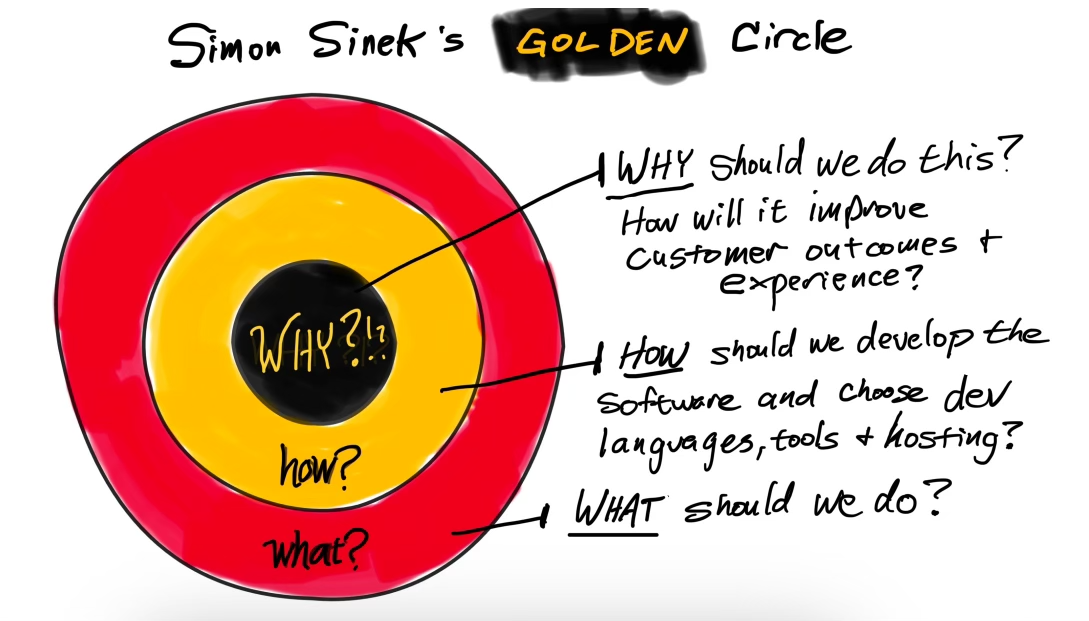
In today’s rapidly evolving tech landscape, innovation and agility are crucial. Companies are constantly racing to release software products that meet market demands, solve real problems, create value, and foster loyalty. Unfortunately, in this race, we also see many companies racing to the bottom in pricing and trying to replicate their competition instead of creating new value for existing and potential customers.
Why is that? It often comes down to a fundamental lack of purpose—a clear understanding of the "why" behind the product or solution. I recently came across one of my favorite TED Talks, "How Great Leaders Inspire Action," by Simon Sinek. It is very timely as we have been working with several clients focused on feature delivery who struggle with new customer adoption with customer service costs outpacing revenue creation.
Sinek is renowned for his Golden Circle Framework, which consists of three layers:
- Why,
- How, and
- What.
He argues that while most companies know “what” they do and “how” they do it, only truly successful organizations start with “why” – the driving purpose, cause, or belief that motivates everything else.
Applying this principle in software development and product management can transform a project from merely functional to exceptional.
Understanding Why Your Customers Want Your Product
Traditional product development often begins with a list of requirements, technical specifications, and feature requests. The tasks for engineers to complete are a project-based waterfall approach, not Product Engineering or Agile. These are the what of the project. Teams then move on to the how—the processes, methodologies, and tools that will bring the product to life. However, by starting with these outer layers, teams risk overlooking the most crucial question: why are we building this product in the first place?
Moving to a focus on why allows for experimentation, the focus is on increasing customer engagement rather than releasing software and moving on to the subsequent feature requests. There are three reasons why starting with the why is beneficial:
1. Clarity of Vision and Purpose
Starting with why ensures that everyone involved in a project—from developers to stakeholders—understands the product's core purpose. This clarity helps align teams around a shared vision. When teams understand the purpose of the software they’re building, it becomes easier to make critical decisions about features, prioritization, and even resource allocation.
For example, if a product team is building a new customer service tool, starting with why might mean understanding that the goal is to improve customer satisfaction and reduce response times—not just to create another chatbot. When everyone understands the deeper purpose, teams are more aligned in their objectives. Developers know what to prioritize, marketers understand how to position the product, and clients see how it fits into their broader business strategy. This alignment creates a more efficient workflow and reduces friction during development.
2. Avoiding Feature Creep
One of the most common pitfalls in software development is feature creep—the tendency to continuously add more and more features, often at the cost of product quality and user experience. When a project is driven primarily by the what, it becomes easy to justify adding features that aren't essential to the product's core purpose. By starting with why, teams can resist the urge to pack in unnecessary features and instead focus on solving the most important problems for their users.
Customers buy why you do something, not what you do. Engineers should focus on delivering solutions that resonate with users’ underlying motivations. This is especially important in today’s competitive landscape, where users have endless choices and are more likely to connect with products that align with their values and goals.
3. Increased Team Motivation and Engagement
It is rumored that when US President John F. Kennedy visited the Apollo program during the space race against the then USSR, he walked over to a janitor and said “Hi, I'm Jack Kennedy. What are you doing?” The janitor responded, “Well Mr. President, I'm helping put a man on the moon.” In that one sentence, the man connected his work to the primary purpose of all NASA employees.
You can tell if you are focused on the why by asking your engineers what they do. Suppose they say functional things (front-end developer, database specialist, etc.) instead of action-oriented responses (I work to delight customers …). In that case, you are still focused on what and how instead of the more important why.
Starting with why motivates teams while increasing project success. When developers and engineers understand the larger purpose behind their work, they’re more likely to feel a sense of ownership and pride in what they’re building.
Conclusion
When product managers and developers are deeply connected to the **why**, they’re more likely to build features that have a meaningful impact on users. This leads to products that meet specifications and exceed user expectations by solving real problems in elegant, user-centric ways.
In an industry where technology is constantly evolving and competition is fierce, the most successful companies don’t just focus on the what and how but start with why. By doing so, they create functional, innovative, meaningful, and impactful products, driving both business success and customer loyalty.
Incorporating this mindset into every stage of software development—from ideation to execution—will help ensure that your teams are not just building products, they are creating lasting value that bolsters your brand and creates long-term commitment.